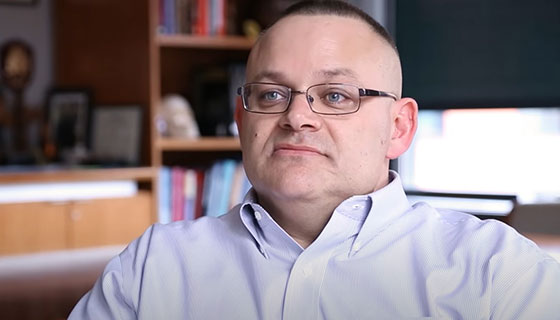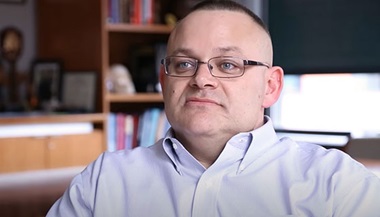Parotid Gland Tumors
Reviewed By:
The parotid glands are the two largest salivary glands in the body. Tumors and masses can grow in the parotid glands, and may require treatment.
David Eisele, M.D., head and neck surgeon and Andelot Professor of Laryngology and Otology and director of the Johns Hopkins Department of Otolaryngology–Head and Neck Surgery, explains how tumors and masses in the parotid gland arise, how they are treated and what patients can expect.
What You Need to Know
- A painless swelling on one side of your face may indicate a mass or tumor on your parotid gland.
- Most parotid tumors are benign (not cancerous). The most common type, pleomorphic adenoma, is slow-growing and has a low chance of becoming malignant.
- Cancer in the parotid gland can arise either from the parotid gland itself or spread (metastasize) to the gland from another place, such as the skin.
- Treatment usually involves surgery to remove the tumor completely.
What is a parotid gland tumor?
You have hundreds of salivary glands in and around your mouth that create saliva, which helps to keep your mouth moist and aids in swallowing, speaking and eating. The major salivary glands are the submandibular (below the jaw), the sublingual (under the tongue) and the parotid glands, which are located by the angle of your jaw in front of the ear. According to the American Cancer Society, parotid masses account for about seven out of 10 salivary gland tumors.
A tumor of the parotid salivary gland arises from an overgrowth of cells. “There are different types of tumors, but the most common type is pleomorphic adenoma, a slow-growing tumor. In very unusual circumstances, this type of tumor can become cancerous,” Eisele says.
Malignant Parotid Tumors
Salivary gland cancer is very rare, but research suggests that the longer a pleomorphic adenoma in the parotid gland remains in place, the higher the chance of it becoming cancerous. About 1.5% of the tumors become malignant in the first five years, rising to 9.5% after 15 years.
Eisele notes that in addition to rare instances when a pleomorphic adenoma turns malignant, a cancerous parotid tumor can arise from skin cancers such as squamous cell carcinoma or melanoma that spread (metastasize) to the gland, which has lymph nodes imbedded inside.
“Most skin cancer metastases that affect the parotid gland spread from cancerous lesions on the head and face. It is less common for a cancer arising in a location below the collarbone to spread to the gland.”
What are the symptoms of a tumor in the parotid gland?
Sometimes patients notice a fullness or swelling of the cheek or an asymmetry in the mouth. Others may experience numbness, burning or pins-and-needles sensations in the face or loss of facial movement.
“Parotid tumors usually do not cause pain,” Eisele notes. “But malignant parotid tumors can invade adjacent structures, including the facial nerve, resulting in facial weakness or paralysis.”
How are parotid tumors diagnosed?
Parotid tumors can involve the superficial lobe or deep lobe of the parotid gland. If your doctor suspects a tumor in this area, he or she is likely to recommend several steps to diagnose and evaluate it.
First, you will undergo imaging studies, or scans. Imaging allows your surgeon to better visualize the extent of the tumor. MRI of the head and neck is the preferred method, but in some cases a CT scan or other imaging studies are used.
Another step in evaluating the mass is taking a sample of tissue from it ― a biopsy ― which can be examined under a microscope by a pathologist.
The most common type of biopsy used for parotid masses is a fine needle aspiration biopsy. In this procedure, the doctor gives you numbing medication and then collects a very small amount of tissue from the tumor with a needle under ultrasound guidance. This is a reliable way to help your head and neck surgeon determine characteristics of the tumor.
If you have already had these tests done at one medical institution and choose another for surgery, your surgeon may request that his or her colleagues in radiology and pathology review your imaging studies and biopsy slides so they can double-check the interpretation of these tests.
Parotid Tumor Treatment: Parotidectomy
Once the imaging studies and biopsy are done, your surgeon will review your case, confer with colleagues and develop a personalized treatment plan. The approach is based on the characteristics of the tumor ― whether it is benign or malignant.
In either case, treatment begins with surgical removal of the tumor, called a parotidectomy. It is important to seek out an experienced head and neck surgeon to perform this procedure.
Eisele says that tumor surgery on one parotid gland is not likely to affect a person’s saliva level since there are so many other salivary glands that can compensate.
Parotidectomy: What Happens
The surgery is typically performed on an outpatient basis, unless a neck dissection or reconstructive procedure is performed at the same time. “The location of the tumor in the parotid gland is important to surgical planning,” Eisele notes. “Those that are deep in the parapharyngeal space can require a special approach.”
- You will be given general anesthesia so you will sleep throughout the procedure.
- The surgeon makes an incision (cut) in the skin to reach the parotid gland. The incision is made where it is less likely to leave a noticeable scar: either in a crease of the neck or hidden along the earlobe and hairline, similar to the approach used in a face-lift.
- Your surgeon and team remove the parotid tumor along with some normal tissue surrounding the mass so it can be removed completely.
- If there are no complications, you will likely be able to return home the same day.
Risks and Complications of Parotidectomy
Facial nerve injury. The surgeons take care to identify the facial nerve, the nerve that controls the face, and trace out its branches. Nerve monitoring during surgery can help identify the nerve so it is protected.
“Sometimes, to reach the parotid tumor, the surgery team must manipulate this nerve,” Eisele explains. “When this happens, you might experience weakness of your face, or a part of it, on one side. This is usually temporary: Permanent facial paralysis is rare.”
If the tumor has surrounded or invaded the facial nerve, that nerve may have to be removed along with the tumor. In this situation, experts in facial plastic and reconstructive surgery will perform a nerve transfer or other facial reanimation procedure.
In addition to facial nerve injury, possible complications include:
- Bleeding
- Infection
- Scarring
- Salivary fistula: saliva leaking through the incision (this is usually temporary)
- Sialocele: a cavity or cyst containing saliva
- Frey’s syndrome: a rare complication of parotid gland surgery that causes sweating or flushing in an area of the face when eating, especially spicy, salty or sour foods
- Seroma: a pocket of serum that forms near the surgical incision
Recovery from Parotid Gland Tumor Surgery
For a parotidectomy alone with no complications, you will likely go home the day of surgery. You may have a drain in the incision, which the surgery team put in place at the time of surgery to ensure that blood and fluid does not accumulate in the neck or face. Eisele notes that the drain is usually removed the day after surgery.
Recovery typically takes one to two weeks after the operation. You should avoid heavy lifting and straining, and follow your doctor’s instructions, including keeping the wound clean and dry.
Salivary Gland Center
The Johns Hopkins Salivary Gland Center offers the latest in evaluation, diagnosis and treatment for patients with salivary gland tumors and other salivary gland disorders.







